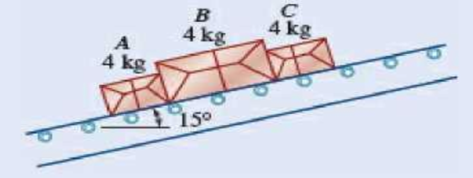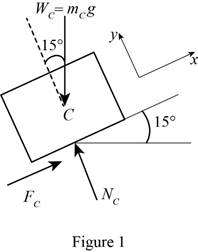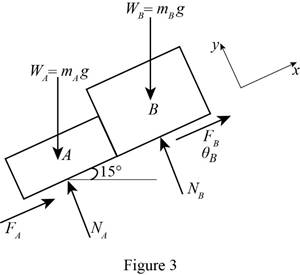
Three 4-kg packages A, B, and C are placed on a conveyor belt that is at rest. Between the belt and both packages A and C, the coefficients of friction are μs = 0.30 and μk = 0.20; between package B and the belt, the coefficients are μs = 0.10 and μk = 0.08. The packages are placed on the belt so that they are in contact with each other and at rest. Determine which, if any, of the packages will move and the friction force acting on each package.

Fig. P8.13
Find whether any of the package moves and the friction force acting on each package.
Answer to Problem 8.13P
The package C will
The friction force in the package C is
The packages A and B will
The friction force in the package B is
The friction force in the package A is
Explanation of Solution
Given information:
The mass of the package A, B, and C is
The static coefficient of friction between packages A and C and the belt is
The static coefficient of friction between package B and belt is
The kinetic coefficient of friction between packages A and C and belt is
The kinetic coefficient of friction between package B and belt is
Calculation:
Consider the acceleration due to gravity as
Consider Block C:
Show the free body diagram of the block C as in Figure 1.

Resolve the vertical component of forces.
Resolve the horizontal component of forces.
Find the maximum friction force
Substitute 0.30 for
The maximum friction force is greater than the friction force.
Therefore, the package C will
Therefore, the friction force in the package C is
Consider Block B:
Show the free body diagram of the block B as in Figure 2.

Resolve the vertical component of forces.
Resolve the horizontal component of forces.
Find the maximum friction force
Substitute 0.10 for
The maximum friction force is less than the friction force.
Therefore, the package B will
Find the friction force in the package B using the kinetic relation.
Substitute 0.08 for
Therefore, the friction force in the package B is
Consider Block A and B together:
Show the free body diagram of the block A and B as in Figure 3.

The normal force in package A is
The normal force in package B is
The friction force in package A is
The friction force in package B is
Find the total normal force in package A and B as follows;
Find the total friction force in package A and B as follows;
The maximum friction force in package A is
The maximum friction force in package B is
Find the maximum friction force
The maximum friction force is less than the friction force.
Therefore, the packages A and B will
Find the friction force in the package A using the kinetic relation.
Substitute 0.20 for
Therefore, the friction force in the package A is
Want to see more full solutions like this?
Chapter 8 Solutions
Vector Mechanics for Engineers: Statics and Dynamics
- Determine the maximum allowable value of weight W at rest. Knowing that the coefficient of static friction between the wall and the block 1 is 0.2, the coefficient of static friction between the floor and block 2 is 0.30 and the coefficient of static friction between the blocks is 0.15arrow_forwardTwo blocks A and B have a weight of 11 lb and 6 lb , respectively. They are resting on the incline for which the coefficients of static friction are μA = 0.16 and μB = 0.23. Determine the angle θ which will cause motion of one of the blocks. What is the friction force under each of the blocks when this occurs? The spring has a stiffness of k = 2 lb/ft and is originally unstretched. Determine the smallest angle θ which will cause motion of one of the blocks. Determine is the friction force under the block A at this angle. Determine is the friction force under the block B at this angle.arrow_forward14 - Masses m1=1kg and m2=2kg are connected to each other by a light rope passing through a frictionless pulley. While mass m1 is connected to a spring with constant k=100 N/m in the horizontal plane with a friction coefficient of µ=0.4, mass m2 hangs freely. It is released when the spring is at its normal length. Calculate the distance h that the m2 mass will descend the most.arrow_forward
- 2.5 kg block is initially at rest on a horizontal surface. A horizontal force of magnitude 5.8 N and a vertical force are then applied to the block. The coefficients of friction for the block and surface are ?s = 0.38 and ?k = 0.23. (a) Determine the magnitude of the frictional force acting on the block if the magnitude of is 8.0 N. N(b) Determine the magnitude of the frictional force acting on the block if the magnitude of is 10.0 N. N(c) Determine the magnitude of the frictional force acting on the block if the magnitude of is 12.0 N. Narrow_forwardIf block A has a mass of 2.0 kg, determine thelargest mass of block B without causing motion of the system. The coefficient of static friction between the blocks and inclined planes is μs= 0.15. Answer must include 2 places after the decimal point and have proper units. g=9.81 m/s^2.arrow_forwardA tractor-trailer rig with a 2000-kg tractor, a 4500-kg trailer, and a 3600-kg trailer is traveling on a level road at 90 km/h. The brakes on the rear trailer fail, and the antiskid system of the tractor and front trailer provide the largest possible force that will not cause the wheels to slide. Knowing that the coefficient of static friction is 0.75, determine (a) the shortest time for the rig to a come to a stop, (b) the force in the coupling between the two trailers during that time. Assume that the force exerted by the coupling on each of the two trailers is horizontal.arrow_forward
- A cable is placed around three parallel pipes. Two of the pipes are fixed and do not rotate; the third pipe is slowly rotated. Knowing that the coefficients of friction are μs= 0.25 and μk= 0.20, determine the largest weight W that can be raised (a) if only pipe A is rotated counterclockwise, (b) if only pipe C is rotated clockwise.arrow_forwardIn the system shown two blocks A and B are joined by anegligible ground cable passing through a fixed pulley that does notbroken. Block A has a mass of 45 kg and the coefficients ofstatic friction are 0.40 between rope and pulley and 0.30 betweenblocks and inclined planes. Determine: a) The maximum mass of block B that will cause theblock A slides down.b) The minimum mass of block B that will cause block A to slide up.c) Explain the condition of the system if the mass of block B were 80 kg.arrow_forwardSolve Prob. 8.13 assuming that package B is placed to the right of both packages A and C.(Reference to Problem 8.13):Three 4-kg packages A, B, and C are placed on a conveyor belt that is at rest. Between the belt and both packages A and C the coefficients of friction are μs= 0.30 and μk= 0.20; between package B and the belt, the coefficients are μs= 0.10 and μk= 0.08. The packages are placed on the belt so that they are in contact with each other and at rest. Determine which, if any, of the packages will move and the friction force acting on each package.arrow_forward
- The force P is applied to the 48-kg block when it is at rest. Determine the magnitude and direction of the friction force exerted by the surface on the block if (a) P = 0, (b) P = 229 N, and (c) P = 354 N. (d) What value of P is required to initiate motion up the incline? The static and kinetic coefficients of friction between the block and the incline are μs = 0.34 and μk = 0.30, respectively. The friction force is positive if up the incline, negative if down the incline.arrow_forwardblock A and B block have a mass of 7 kg and 10 kg, respectively. Using the indicated static friction coefficients, determine the greatest vertical force P that can be applied to the wire without causing motion. Uniformsarrow_forwardA 60 kN load is placed on two tires of a locked-wheel trailer. At a speed of 48 km/h, a force of 30 kN is required to move the device. Determine the friction factor.arrow_forward
 Elements Of ElectromagneticsMechanical EngineeringISBN:9780190698614Author:Sadiku, Matthew N. O.Publisher:Oxford University Press
Elements Of ElectromagneticsMechanical EngineeringISBN:9780190698614Author:Sadiku, Matthew N. O.Publisher:Oxford University Press Mechanics of Materials (10th Edition)Mechanical EngineeringISBN:9780134319650Author:Russell C. HibbelerPublisher:PEARSON
Mechanics of Materials (10th Edition)Mechanical EngineeringISBN:9780134319650Author:Russell C. HibbelerPublisher:PEARSON Thermodynamics: An Engineering ApproachMechanical EngineeringISBN:9781259822674Author:Yunus A. Cengel Dr., Michael A. BolesPublisher:McGraw-Hill Education
Thermodynamics: An Engineering ApproachMechanical EngineeringISBN:9781259822674Author:Yunus A. Cengel Dr., Michael A. BolesPublisher:McGraw-Hill Education Control Systems EngineeringMechanical EngineeringISBN:9781118170519Author:Norman S. NisePublisher:WILEY
Control Systems EngineeringMechanical EngineeringISBN:9781118170519Author:Norman S. NisePublisher:WILEY Mechanics of Materials (MindTap Course List)Mechanical EngineeringISBN:9781337093347Author:Barry J. Goodno, James M. GerePublisher:Cengage Learning
Mechanics of Materials (MindTap Course List)Mechanical EngineeringISBN:9781337093347Author:Barry J. Goodno, James M. GerePublisher:Cengage Learning Engineering Mechanics: StaticsMechanical EngineeringISBN:9781118807330Author:James L. Meriam, L. G. Kraige, J. N. BoltonPublisher:WILEY
Engineering Mechanics: StaticsMechanical EngineeringISBN:9781118807330Author:James L. Meriam, L. G. Kraige, J. N. BoltonPublisher:WILEY





